Last night’s Four Corners report on a ‘Big Australia’ was another huge disappointment.
Its key failing was that it took a fatalistic approach to Australia’s turbo-charged population growth – and the migrant intake more specifically – assuming a ‘Big Australia’ of more than 40 million people mid-century is inevitable and even desirable.
There was no suggestion that how ‘Big’ Australia becomes is a direct policy choice of the federal government, who sets Australia’s permanent migrant intake (currently 208,000 people a year, including the humanitarian intake):
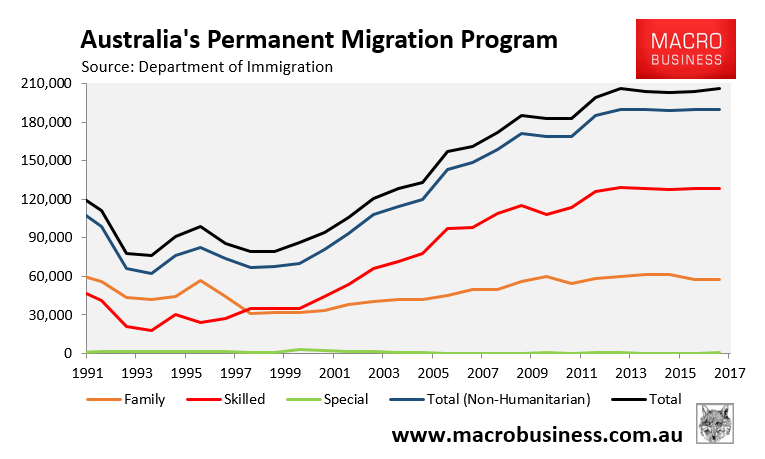
This contribution from mass immigration to Australia’s population growth was made abundantly clear by the Productivity Commission’s (PC) 2016 Migrant Intake Australia report, which showed that Australia’s population would hit just 27 million by 2060, versus more than 40 million under current mass immigration settings:
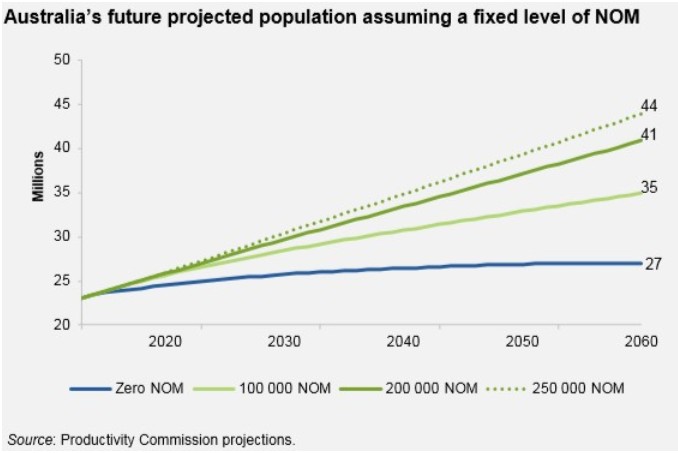
The whole Four Corners report was about how Australians need to get used to change – specifically living in apartments, worsening traffic congestion, and reduced livability – as if we have no choice in the matter and a ‘Big Australia’ is a fait accompli.
Reporter Ben Knight even stated on numerous occasions that this population growth is “our choice”, rather than forced upon us by poor government policy, with Ben Knight even claiming that today’s generation has “more opportunities than generations before”, which is obviously bunk given the shocking decline in opportunities in the housing and the labour markets.
In a similar vein, Saul Eslake stated that Australians “need to make compromises for the greater good” (i.e. so that we can accomodate millions of migrants). And it was insinuated over and over again that Australians are somehow selfish for wanting the same quality of life enjoyed by their parents and grandparents, such as living in a detached house with a backyard.
The segment played lipservice to problems caused by excessive population growth – such as traffic congestion – but again the suggestion was that we’ll just have to get used to it because a ‘Big Australia’ is inevitable. It also spruiked that the major cities will need to develop mass transit systems, like heavy rail, but failed to explain: 1) how this will be funded; and 2) that this would make our cities even more CBD centric and centralised, rather than decentralised.
The fact of the matter is that Infrastructure Australia’s latest report showed that no matter what Melbourne and Sydney do to cope with the migrant influx, public transport’s modal share will barely increase, road congestion will dramatically worsen, and access to jobs, schools, hospitals and green space will all deteriorate as Melbourne’s and Sydney’s populations balloon to 7.3 and 7.4 million people respectively by 2046:
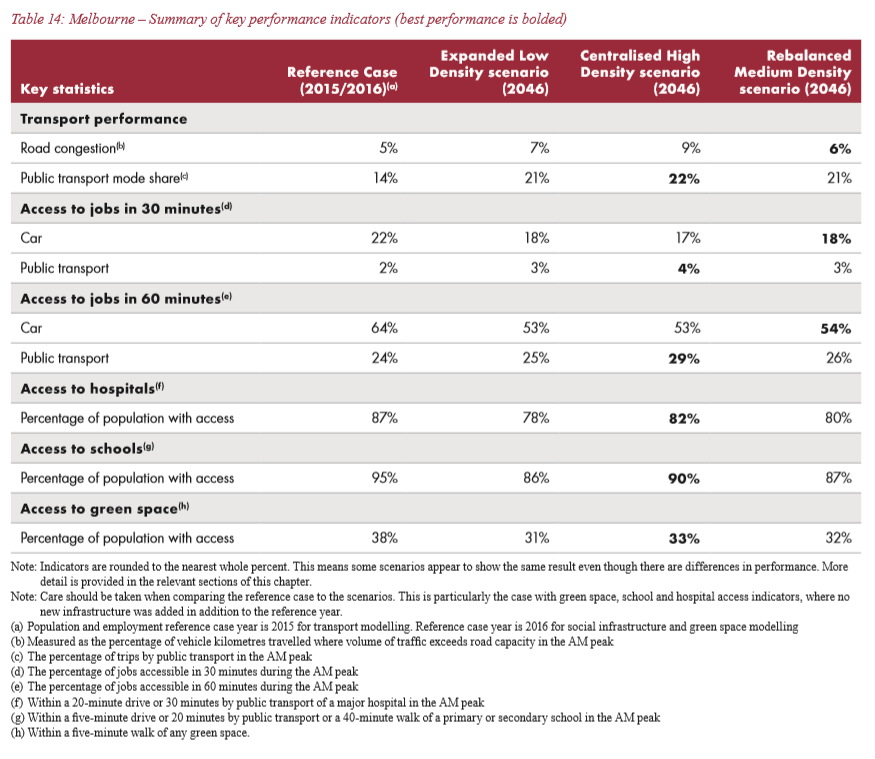
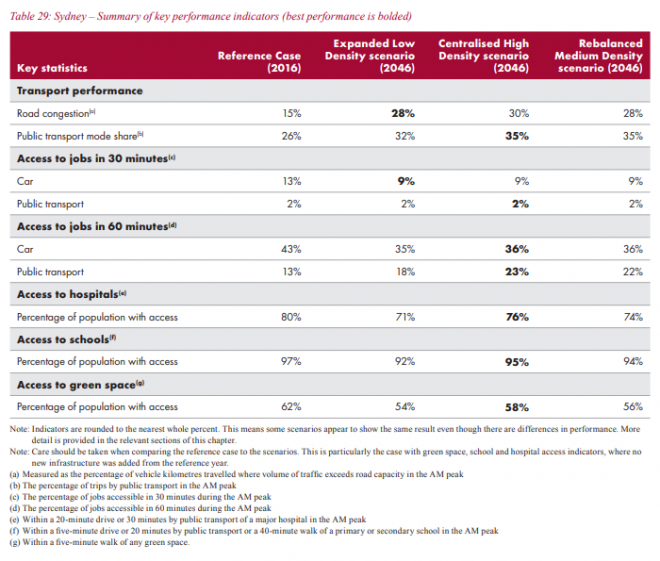
Is this a future Australians want? Why aren’t we being given a choice on the matter? Again, it’s a direct policy choice how ‘Big” Australia becomes, dependent primarily on Australia’s immigration intake.
Next, the segment was stacked with mass immigration boosters, such as Bernard Salt, Innes Willox, Liz Allen, Peter McDonald, and Saul Eslake, but included only two dissenters in Dick Smith and Bob Carr, who received minimal airtime.
Finally, the Four Corners report didn’t even mention adverse impacts on the environment – not one mention!
Overall, this was a poor report by Four Corners and another missed opportunity for a meaningful debate.
Q&A also did the immigration debate with a couple of panelists making sense (among a sea of hopelessness). Bob Carr did a good job on the class war:
“I’m interested that the first poll I have seen indicates a big shift in public attitudes on this, it came out in recent months. It shows 74 per cent of Australians think there is enough of us already and someone who has been talking on ecological and economic grounds for less immigration rather than more, I find that interesting. That is the first breakthrough.
I think politicians and business leaders ought to be acknowledging that it has finally sunk in – I thought it was a lonely voice for the long time.
Immigration is our character, 37 per cent of the population of Sydney was born overseas, we celebrate it, but even those people, those born overseas are still asking whether we can achieve the same benefits at a less dramatic pace. It is the highest in the world. It’s the highest in the world. Do we really want to be adding a million to our population every three-and-a-half years? Would it be such a departure from God’s eternal plan for this continent if we took six years about acquiring an extra six million?
…A very quick response is about the failure of our Skilled Migration Program, the most recent study that I read shows that you could abolish it tomorrow without any employers seeing the difference. We are importing professionals, and we are importing professionals who are unemployed. Now, we’ve got to reassess the notion we hold that the Skilled Migration Program is delivering relief.”
Also making sense was Tim Flannery:
“Having lived through government after government that has promised to fix them with decentralisation or new projects – it’s never happened. You asked are politicians, do they understand how angry people are? There’s an underlying issue there which is about why is this problem occurring? It’s because politicians with very few exceptions, such as Bob, none of them want a smaller constituency, none of our church leaders want a smaller congregation, so unless we, the people, speak up on this, and are heard and control the agenda, special interest groups will see population growth continue.”
“…we have left it to the experts, to politicians and we have ended up with a mess. I have got enormous faith in the common-sense of just average Australians. I can’t think of a better way of dealing with this than to put the power back into the hands of well-informed Australians, through something like a jury system. 200 of us chosen at random and given access to all the facts and asked to make a decision and given a time to do it and paid to do it would come up with a decision that would be representative of what Australians want.”
Hear, hear. We all know what the result would be.
Below is MB’s submission to the federal government’s Migration Program review, which covers the issues Four Corners was too afraid to discuss.
_______________________________________________________________________
February 2018
THE BLIND MARCH TOWARDS A ‘BIG AUSTRALIA’
Submission to the Department of Home Affairs’ Managing Australia’s Migrant Intake Review
Summary
At MacroBusiness we support immigration, but at sustainable levels.
Australia’s immigration levels are too high – higher than our cities can absorb. The infrastructure costs of high immigration are excessive and Australia’s infrastructure supply is not keeping up with demand, despite our best efforts.
The economic arguments frequently used to justify high immigration fail the evidence test. Empirical data does not support mass immigration. Excessive immigration also damages Australia’s employment market and the environment.
It is time for an honest debate.
Currently, Australia’s immigration program is overloading the major cities with tens of thousands of extra people each year to stoke overall economic growth (but not growth per person) and to support business (e.g. the property industry and retailers), despite growth per person stagnating.
Meanwhile, individual living standards are being eroded through rising congestion costs, declining housing affordability, paying more for infrastructure (e.g. toll roads and water), environmental degradation, and overall reduced amenity.
The economic evidence for the above is contained in this submission.
The Australian Government needs to stop ignoring these issues. Australia’s living standards are at stake.
MacroBusiness urges the Australian Government to reduce Australia’s immigration intake back towards the historical average of around 70,000 people per annum.
1. Australia’s immigration program is unprecedented:
One of the most profound changes affecting the Australian economy and society this century has been the massive lift in Australia’s net immigration, which surged from the early-2000s and is running at roughly triple the pace of historical norms (Chart 1).
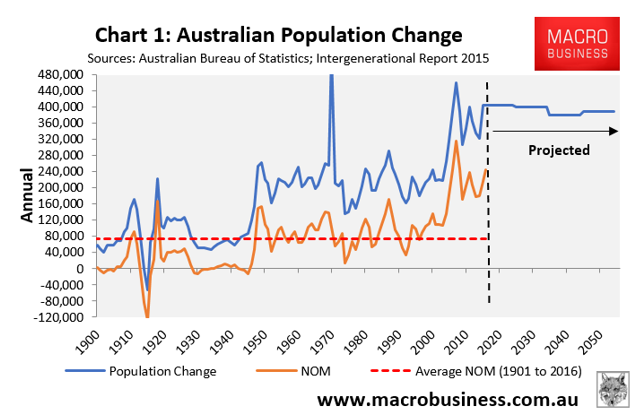
In the 116 years following Australia’s Federation in 1901, Australia’s net overseas migration (NOM) averaged around 73,000 people a year and Australia’s population grew on average by around 180,000 people.
Over the past 12 years, however, Australia’s annual NOM has averaged nearly 220,000 people a year and Australia’s population has grown on average by 370,000 people.
The principal driver of Australia’s population increase has been the Australian Government’s permanent migrant intake, which has increased from 79,000 in 1999 to nearly 210,000 currently, including the humanitarian intake (Chart 2).
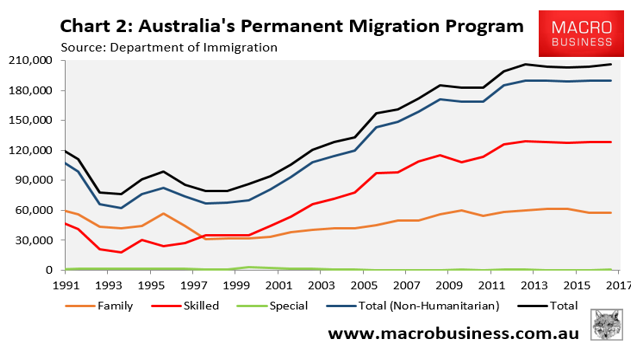
Due to this mass immigration ‘Big Australia’ policy, Australia’s population has expanded at a rate that is more than 2.5 times the OECD average, easily the fastest of advanced English-speaking nations (Chart 3).
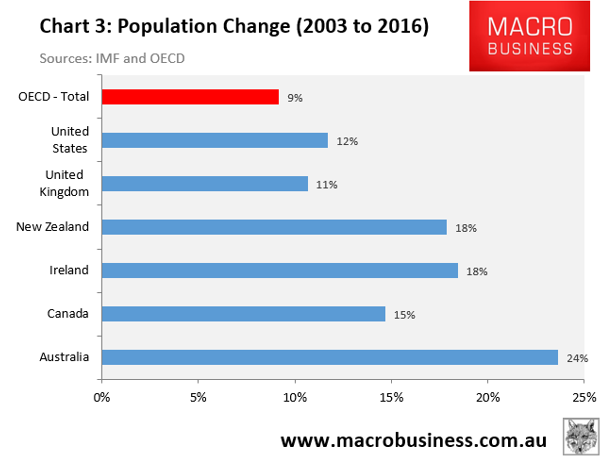
This rapid population growth is expected to continue for decades to come, with the Australian Government’s Intergenerational Report projecting population growth of nearly 400,000 people a year – equivalent to one Canberra – until Australia’s population reaches 40 million mid-century (see Chart 1 above).
However, the problem with Australia’s mass immigration policy is not just the extreme volume, but also the concentration of migrants flowing to Australia’s largest and already most overcrowded cities.
As shown in Chart 4, around three quarters of Australia’s NOM has flowed to New South Wales and Victoria, principally Sydney and Melbourne:
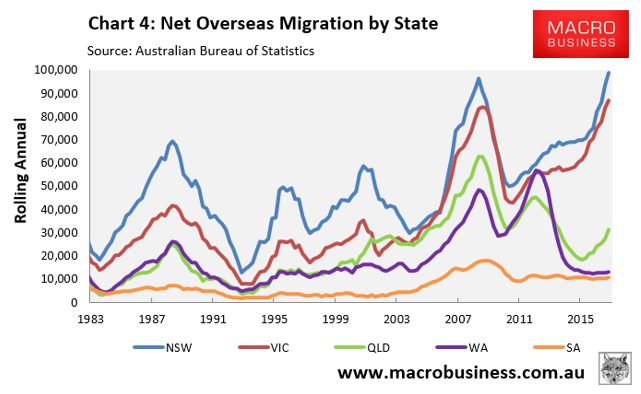
In the 12 years to 2016, Melbourne’s population expanded by nearly 1.1 million (30%), while Sydney’s population expanded by 845,000 (20%). There was also strong growth in Brisbane (537,000) and Perth (502,000) (Charts 5 and 6).
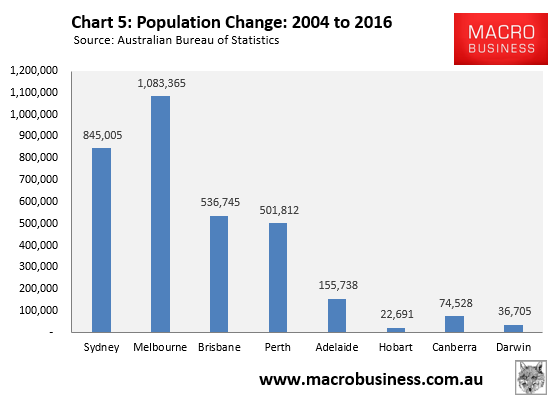
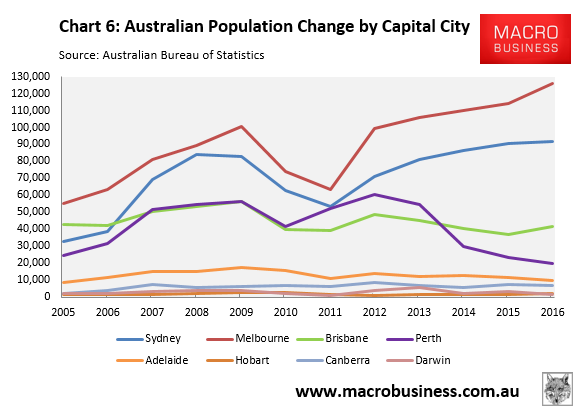
The migrant influx helps to explain why dwelling price growth has been strongest in Sydney and Melbourne, and why housing is most unaffordable in these two cities (Charts 7 and 8). While the Australian Government and property lobby likes to blame a ‘lack of supply’, the problem rests primarily with excessive demand from mass immigration.
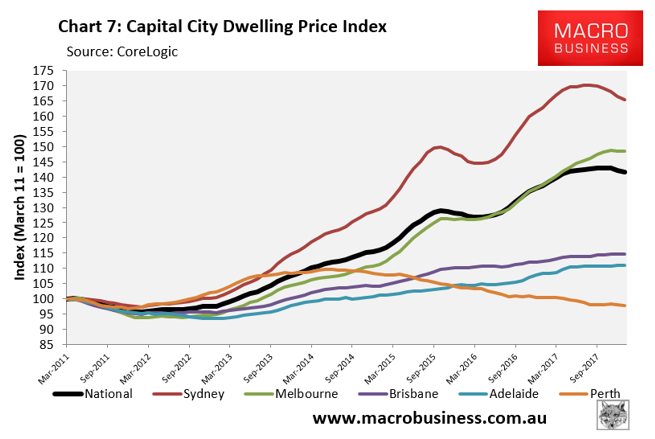
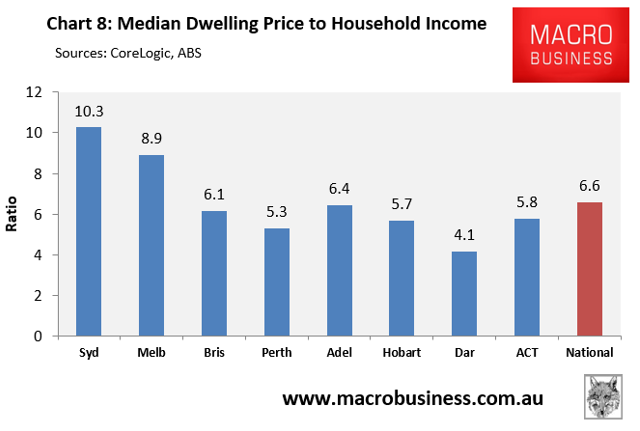
The chronic problems around housing and infrastructure will only get worse under the current mass immigration policy.
State Government projections have Melbourne’s population expanding by 97,000 people each year (1,870 people a week) and Sydney’s by 87,000 people each year (1,670 people each week) for the next several decades until both cities’ populations hit around 8 million people mid-century.
To put this population growth into perspective, consider the following facts:
- It took Sydney around 210 years to reach a population of 3.9 million in 2001. And yet the official projections have Sydney adding roughly the same number of people again in just 50 years.
- It took Melbourne nearly 170 years to reach a population of 3.3 million in 2001. In just 15 years, Melbourne expanded by 34% to 4.5 million people. And the official projections have Melbourne’s population ballooning by another 3.4 million people in just 35 years.
No matter which way you cut it, residents of our two largest cities will continue to feel the impact of this rapid population growth via: traffic gridlock; overloaded public transport, schools, and hospitals; pressures on energy and water supplies; as well as more expensive (and smaller) housing.
It is a clear recipe for lower living standards.
2. No economic bonanza:
Politicians and economists frequently claim that maintaining a ‘strong’ immigration program is essential as it keeps the population young and productive, and without constant immigration, the population would grow old and the economy would stagnate.
For example, Prime Minister Malcolm Turnbull has stated previously that “anyone who thinks it’s smart to cut immigration is sentencing Australia to poverty”. In a similar vein, former KPMG partner and “unabashed supporter of a bigger Australia”, Bernard Salt, has produced reams of articles warning that Australia faces economic and fiscal catastrophe without ongoing strong immigration.
Economic models are often cited as proof that a strong immigration program is ‘good’ for the economy because they show that real GDP per capita is moderately increased via immigration, based on several dubious assumptions.
First, it is generally assumed in these models that population ageing will result in fewer people working, which will subtract from per capita GDP. However, it is just as likely that age-specific workforce participation will respond to labour demand, resulting in fewer people being unemployed, as we have witnessed in Japan, where the unemployment rate is below 3%.
Even if this assumption was true, the benefit to GDP per capita would only be transitory. Once the migrant workers grow old, they too will add to the pool of aged Australians, thus requiring an ever increasing immigration intake to keep the population age profile from rising.
Indeed, the Productivity Commission (PC) has for more than a decade debunked the myth that immigration can overcome population ageing. For example, in its 2010 submission to the Minister for Population, the PC explicitly noted that “substantial increases in the level of net overseas migration would have only modest effects on population ageing and the impacts would be temporary, since immigrants themselves age”.
Academic demographer, Peter McDonald, has also previously stated that it is “demographic nonsense to believe that immigration can help to keep our population young” .
Second, it is generally assumed that migrant workers are more productive than the Australian born population and, therefore, labour productivity is increased through strong immigration. However, the evidence here is highly contestable, with migrants generally being employed below the level of their qualifications, as well as having lower labour force attachment than the Australian born population (more information here).
Third, economists and their models generally ignore obvious ‘costs’ of mass immigration on productivity. Growing Australia’s population without commensurately increasing the stock of household, business and public capital to support the bigger population necessarily ‘dilutes’ Australia’s capital base, leaving less capital per person and lowering productivity. We have witnessed this first hand with the costs of congestion soaring across Australia’s big cities.
Moreover, the cost of retro-fitting our big cities with infrastructure to cope with larger populations is necessarily very expensive – think tunnelling and land acquisitions – with costs borne largely by the incumbent population. This fact was explicitly acknowledged by the PC’s recent Shifting the Dial: 5 year productivity review:
“Growing populations will place pressure on already strained transport systems… Yet available choices for new investments are constrained by the increasingly limited availability of unutilised land. Costs of new transport structures have risen accordingly, with new developments (for example WestConnex) requiring land reclamation, costly compensation arrangements, or otherwise more expensive alternatives (such as tunnels)” .
Finally, while economic models tend to show a modest improvement in real GDP per capita, the gains are more likely to flow to the wealthy, whereas ordinary workers are made worse-off.
In 2006, the PC completed a major study on the Economic Impacts of Migration and Population Growth, which modelled the impact of a 50% increase in the level of skilled migration over the 20 years to 2024-25. The modelling found that even skilled migration does not increase the incomes of existing residents. According to the Commission: “the distribution of these benefits [from skilled migration] varies across the population, with gains mostly accrued to the skilled migrants and capital owners. The incomes of existing resident workers grow more slowly than would otherwise be the case” .
Of course, there are other costs borne by incumbent residents from immigration that are not captured in the economic modelling, such as worsening congestion, increased infrastructure costs, reduced housing affordability, and environmental degradation – none of which are given appropriate consideration by politicians nor economists.
Adding a Canberra-worth of population to Australia each and every year – with 80,000 to 100,000-plus people going to Sydney and Melbourne – requires an incredible amount of investment just to keep up. Accordingly, Australia’s infrastructure deficit has fallen badly behind over the past decade, and will continue to do so under Australia’s mass immigration program, thus eroding residents’ living standards.
3. Empirical data does not support mass immigration:
While the economic models might show small per capita gains from immigration-fuelled population growth, based on faulty assumptions, the actual empirical evidence shows no link between population growth and prosperity.
Since Australia’s immigration intake was expanded in the early-2000s, trend GDP per capita growth has plummeted to recessionary levels, suggesting falling living standards (Chart 9).
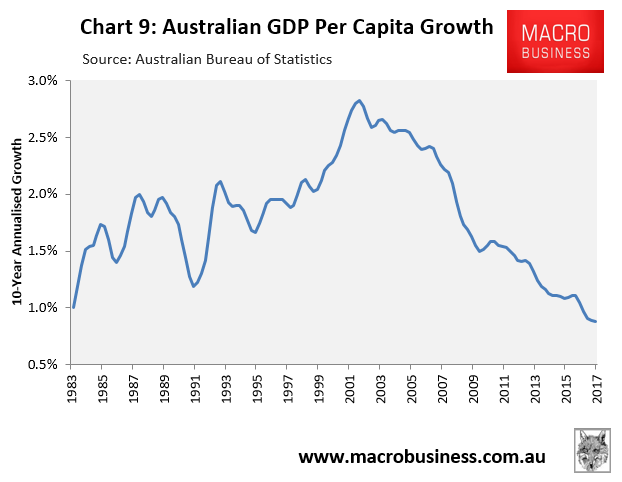
Chart 10 plots the growth in GDP per capita versus population change between 2000 and 2016 across OECD nations and shows no correlation (Australia denoted in red):
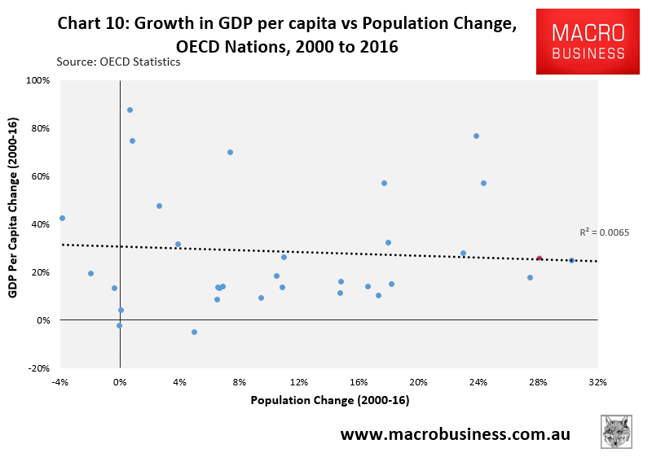
Meanwhile, there is a slight negative relationship between labour productivity and population growth (Chart 11):
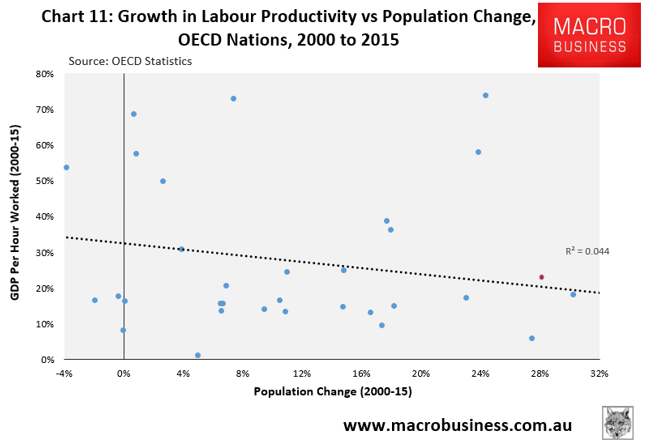
Whereas there is zero correlation between population growth and multifactor productivity across OECD nations:
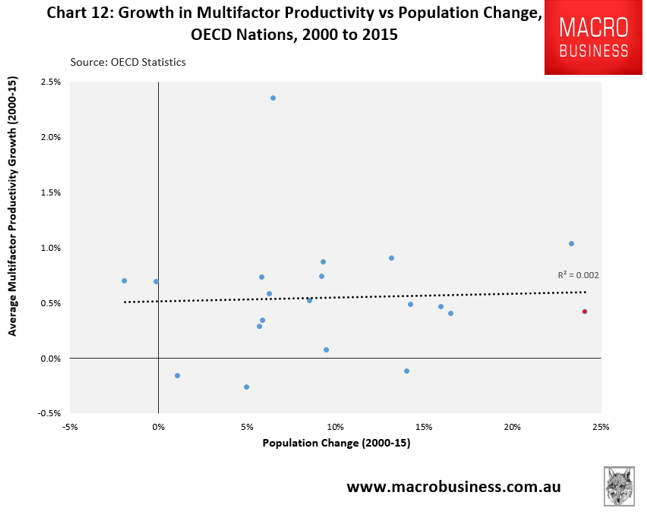
A recent study by economists at the Massachusetts Institute of Technology (MIT) also found “that even when we control for initial GDP per capita, initial demographic composition and differential trends by region, there is no evidence of a negative relationship between aging and GDP per capita; on the contrary, the relationship is significantly positive in many specifications” (Chart 13).
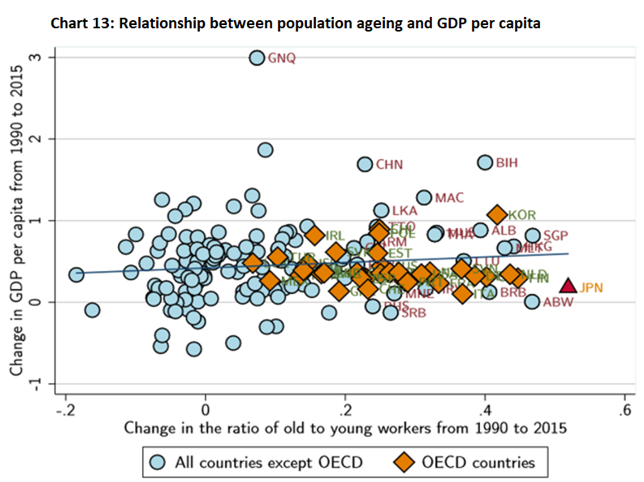
There is also evidence to suggest that mass immigration is partly behind Australia’s trade and current account deficits, as well as the nation’s ballooning foreign debt.
The lion’s share of Australia’s export revenue comes from commodities and from Western Australia and Queensland in particular (Chart 14):
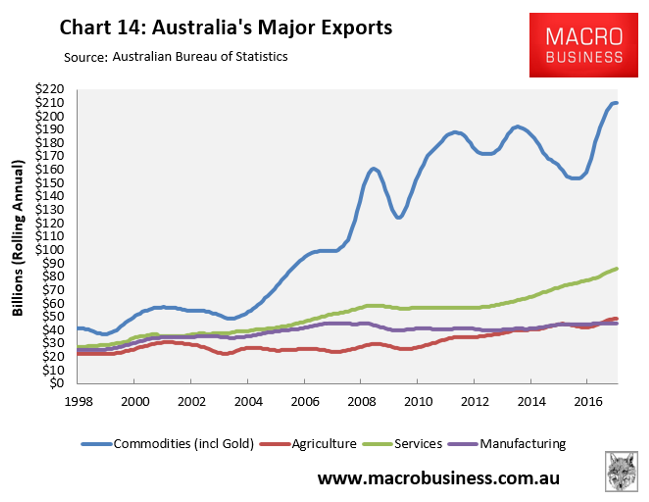
However, the majority of Australia’s imports and indeed private debt flows to our biggest states (and cities), New South Wales (Sydney) and Victoria (Melbourne). Sydney and Melbourne also happen to be the key magnets for migrants (see Charts 4,5 and 6 above).
Increasing the number of people via mass immigration does not materially boost Australia’s exports but does significantly increase imports (think flat screen TVs, imported cars, etc.). Accordingly, both New South Wales and Victoria have driven huge trade deficits as the extra imports have far outweighed exports (Chart 15):
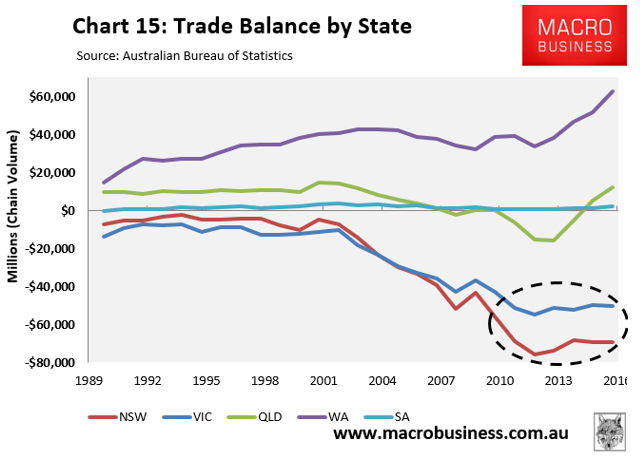
All of these extra imports must be paid for – either by accumulating foreign debt, or by selling-off the nation’s assets. Australia has been doing both.
Australia would improve its trade balance and current account deficit, as well as reduce the need to sell-off assets and binge on debt, if it simply cut immigration.
Australia will ship the same amount of hard commodities and agriculture regardless of how many people are coming in as all the productive capacity has been set up and it doesn’t require more labour.
4. Lowering immigration would raise wages:
Hand wringing over Australia’s anaemic wages growth (Chart 16) hit fever pitch recently, with politicians, economists and media all searching for answers.

One cause that has received scant attention is the role caused by mass immigration in driving-up labour supply and reducing the bargaining power of workers.
Employer groups often argue that a strong ‘skilled’ migration program is required to overcome perceived labour shortages – a view that is supported by the Australian Government. However, the available data shows this argument to be weak.
The Department of Employment’s 2016-17 Skills Shortages report revealed that Australian skills shortages “continue to be limited in 2016-17”, and that there are a high number of applicants per job (Chart 17):
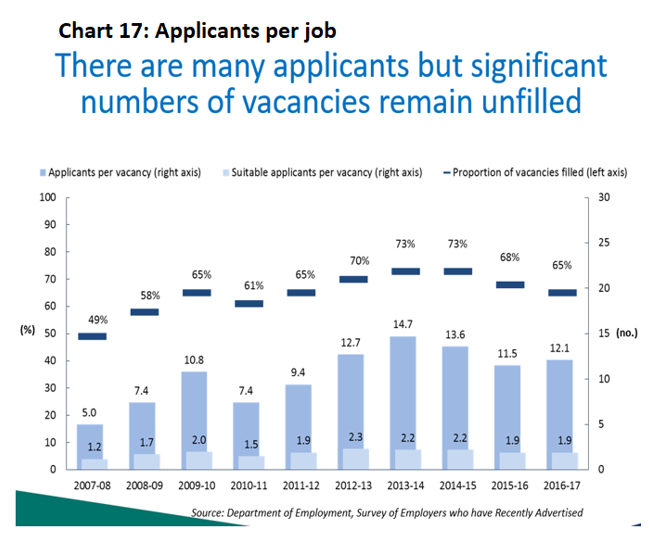
The Department of Employment also revealed a record number of Australians studying at university (Chart 18):
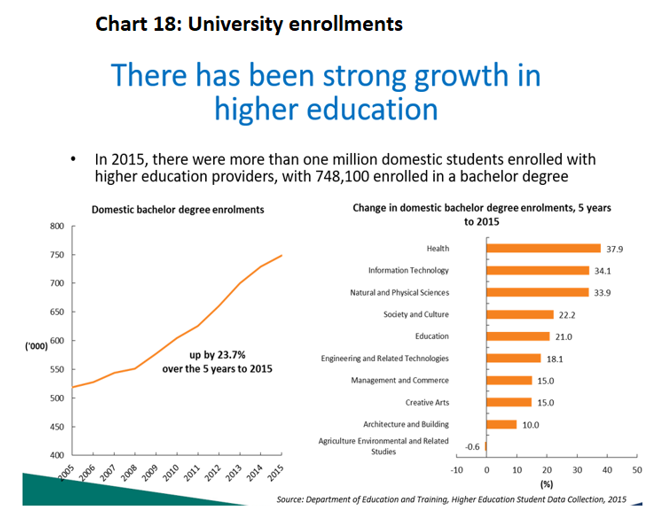
Of whom many graduates cannot gain meaningful employment (Chart 19):
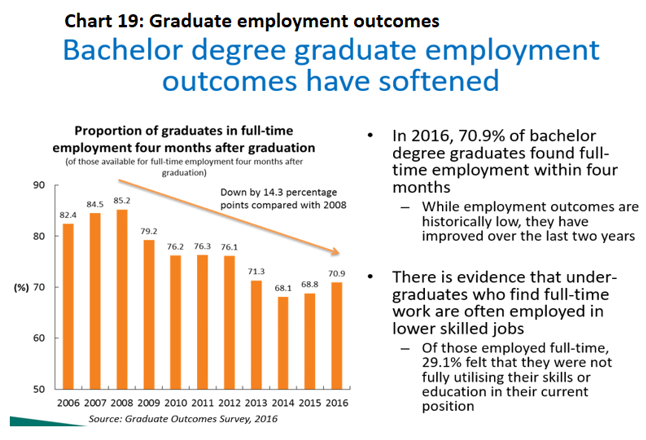
The Australian Bureau of Statistics’ labour force data also shows that Australia’s underutilisation rate remains high, especially for Australia’s youth, despite the recent improvement in the labour market (Chart 20).
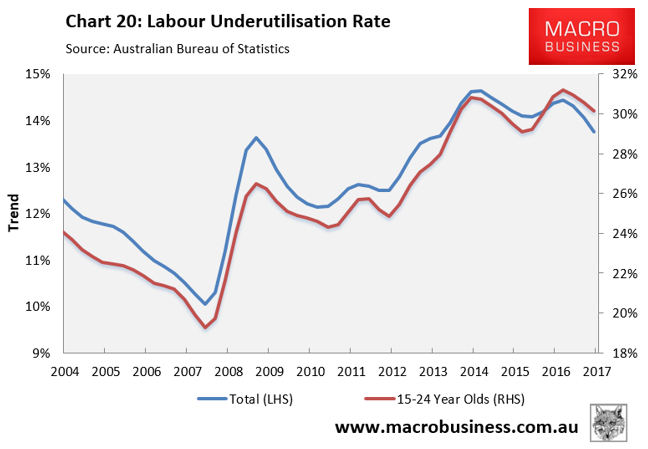
Curiously, Australia’s permanent skilled migrant intake is significantly higher today (128,550) than it was at the peak of the mining boom in 2011 (113,850). Why? Unlike then, labour shortages are “limited”, wages growth is running near the lowest level on record, and labour underutilisation is high. What is the economic rationale for running the highest permanent migrant intake on record when economic conditions do not warrant it?
Standard economic theory claims that net inward migration has minimal long-term impact on wages. That is, when the quantity of labour increases, its price (wages) falls. This will supposedly increase profits, eventually leading to more investment, increased demand for labour, and a reversal of the initial fall in wages. Immigration, so the theory goes, will enable the larger domestic population to enjoy the same incomes as the smaller population did before.
However, a recent study by Cambridge University economist, Robert Rowthorn, debunked this argument. The so-called ‘temporary’ effects of displacing incumbent workers and lower wages can last for up to ten years. And if there is a continuing influx of migrants – as is the case in Australia – rather than a one-off increase in the size of the labour force, demand for labour will constantly lag behind growth in supply .
In other words, if the Australian Government was to stem the inflow of foreign workers, then workers’ bargaining power would increase, as will wages growth. It is basic economics.
As noted in April last year by The Australia Institute’s chief economist, Richard Denniss, the very purpose of foreign worker visas is to “suppress wage growth by allowing employers to recruit from a global pool of labour to compete with Australian workers”. In a normal functioning labour market, “when demand for workers rises, employers would need to bid against each other for the available scarce talent”. But this mechanism has been bypassed by enabling employers to recruit labour globally. “It is only in recent years that the wage rises that accompany the normal functioning of the labour market have been rebranded as a ‘skills shortage'” .
Australia’s youth is effectively caught in a pincer by the Australian Government’s mass immigration program. Not only does it hold down their wages, but it also inflates their cost-of-living via more expensive housing (both prices and rents).
5. It’s time for a national debate and population policy:
The Australian Government under both the Coalition and Labor has long supported mass immigration and a ‘Big Australia’ on flawed economic grounds.
Behind the scenes, the ‘growth lobby’ of retailers, the banking sector, the property industry and erroneously named ‘think tanks’ all push the growth-ist agenda, while completely ignoring the cost burden on ordinary residents.
At the same time, many on the left pursue the globalist agenda of ‘open borders’ citing spurious social justice concerns.
Currently, there is no coherent plan other than to inundate the major cities with extra people each and every year to stoke overall economic growth (but not growth per person), to support big business (e.g. the property industry and retailers), and to prevent Australia from going into recession (despite growth per person stagnating).
Meanwhile, individual living standards are being eroded through rising congestion costs, declining housing affordability, paying more for infrastructure (e.g. toll roads, water and energy), environmental degradation, and overall reduced amenity.
Never have Australians been asked whether they want a population of 40 million-plus mid-century. Nor whether they want Sydney’s and Melbourne’s populations to swell to eight million mid-century.
Yet immigration and population growth affects every facet of Australian life, including: how long one spends stuck in traffic; whether one can get a seat on a train or a spot in hospital or school; and/or whether one can afford a good sized home within a decent commute to where one works. It is a key determinant of living standards above all else, yet is rarely questioned by the media nor politicians.
Without mainstream political representation on this issue, divisive elements like Pauline Hanson’s One Nation party have emerged to wrongly use the ills of overpopulation to attack the small number of refugees arriving in Australia, as well as Muslim and Asian immigration.
As this submission has shown, there is strong justification to reduce Australia’s permanent migrant intake back to historical levels primarily by slashing skilled migration, which has been the driver of the influx. This would take the strain off the major cities, put a floor under wages growth, and safeguard Australia’s environment.
Australia could achieve such immigration cuts without affecting its global obligations via the humanitarian migrant intake. Indeed, much of Australia’s 130,000 strong permanent skilled migrant intake comes from countries where skills are more desperately needed than in Australia. Australia’s immigration program is depriving these countries of skills, and we have a moral obligation to limit the brain drain.
More broadly, Australia desperately needs a national debate and a population strategy, led by the Australian Government. The Government needs to conduct a population plebiscite asking Australians how big they want the nation to become, and then set immigration policy accordingly. The Australian Government also needs to provide a comprehensive plan detailing how and where it will accommodate all the extra people, while safeguarding incumbent residents’ living standards.

